Organizational Behaviour: Development and Change Management Analysis
VerifiedAdded on 2023/04/08
|10
|1433
|61
Essay
AI Summary
This essay explores organizational development as a systematic approach to planned change, emphasizing its role in enhancing organizational effectiveness and employee performance. It discusses the significance of proactive steps in organizational change and highlights Toyota's organizational structure modifications as an example of continuous improvement. The essay further examines the role of organizational development in change management, addressing employee resistance and the importance of understanding key stakeholders. It contrasts top-down change approaches with organizational development's focus on employee involvement and cultural reinforcement, ultimately advocating for a holistic approach to managing change within organizations. Desklib provides access to this and many other solved assignments for students.
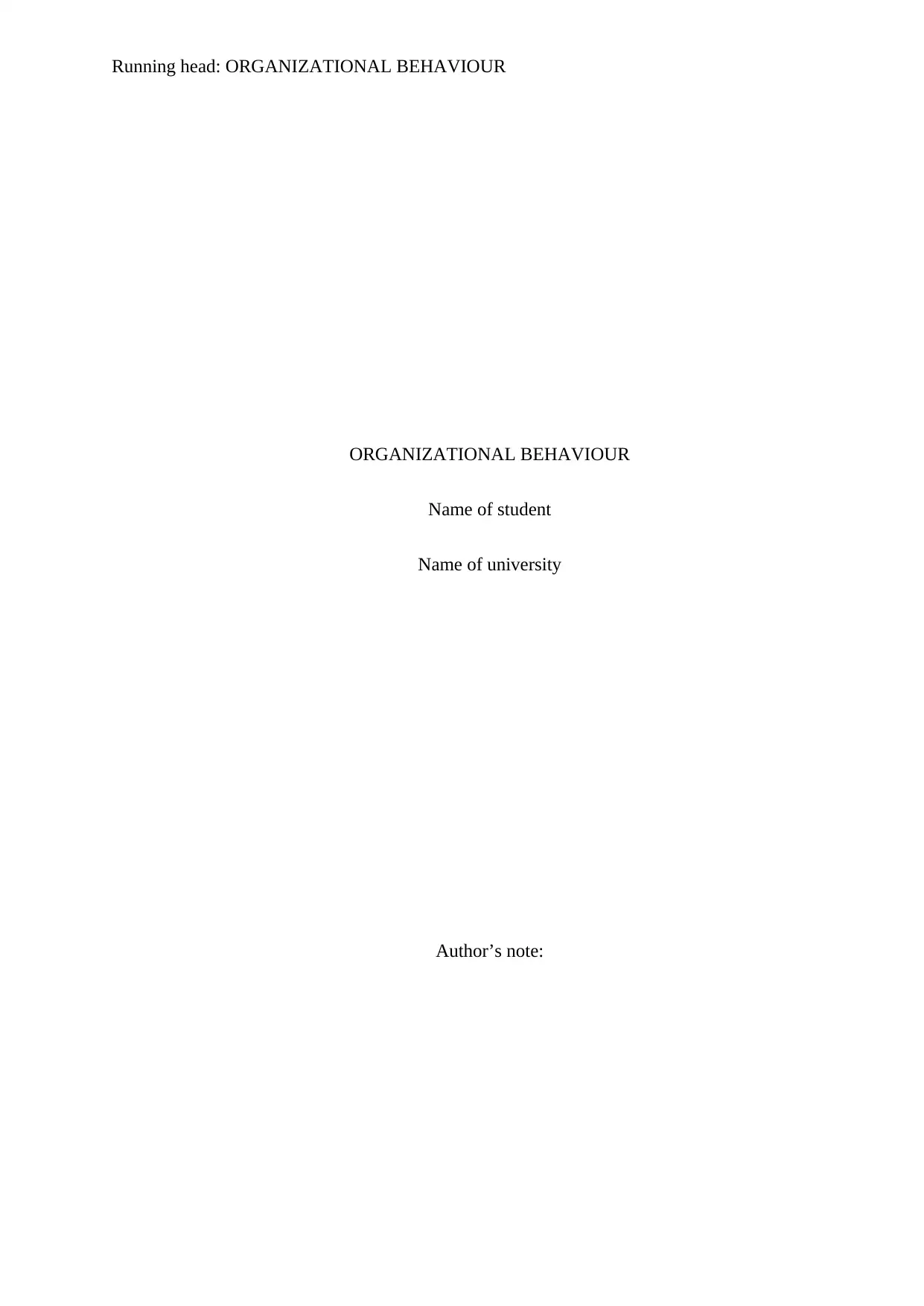
Running head: ORGANIZATIONAL BEHAVIOUR
ORGANIZATIONAL BEHAVIOUR
Name of student
Name of university
Author’s note:
ORGANIZATIONAL BEHAVIOUR
Name of student
Name of university
Author’s note:
Paraphrase This Document
Need a fresh take? Get an instant paraphrase of this document with our AI Paraphraser
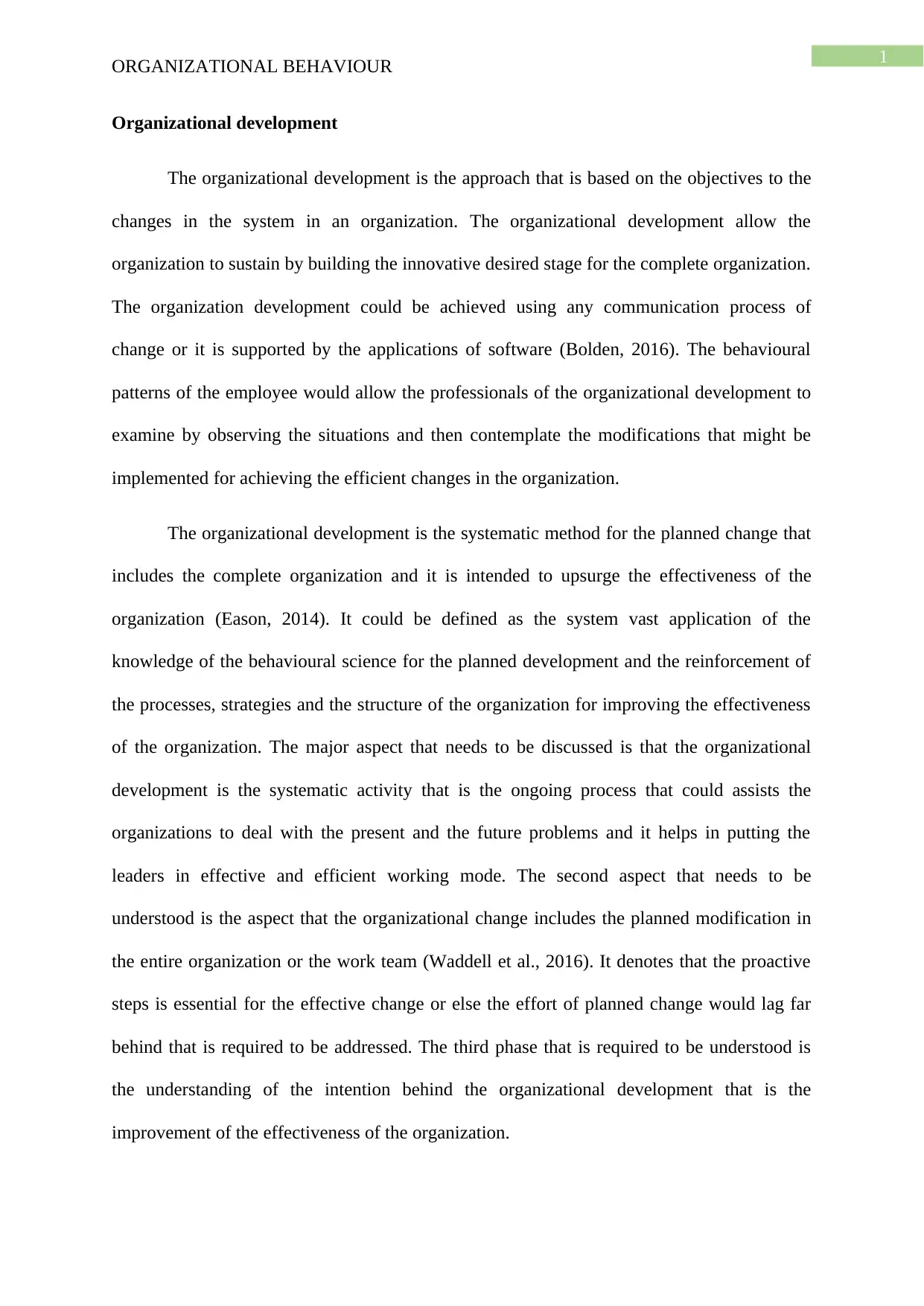
1
ORGANIZATIONAL BEHAVIOUR
Organizational development
The organizational development is the approach that is based on the objectives to the
changes in the system in an organization. The organizational development allow the
organization to sustain by building the innovative desired stage for the complete organization.
The organization development could be achieved using any communication process of
change or it is supported by the applications of software (Bolden, 2016). The behavioural
patterns of the employee would allow the professionals of the organizational development to
examine by observing the situations and then contemplate the modifications that might be
implemented for achieving the efficient changes in the organization.
The organizational development is the systematic method for the planned change that
includes the complete organization and it is intended to upsurge the effectiveness of the
organization (Eason, 2014). It could be defined as the system vast application of the
knowledge of the behavioural science for the planned development and the reinforcement of
the processes, strategies and the structure of the organization for improving the effectiveness
of the organization. The major aspect that needs to be discussed is that the organizational
development is the systematic activity that is the ongoing process that could assists the
organizations to deal with the present and the future problems and it helps in putting the
leaders in effective and efficient working mode. The second aspect that needs to be
understood is the aspect that the organizational change includes the planned modification in
the entire organization or the work team (Waddell et al., 2016). It denotes that the proactive
steps is essential for the effective change or else the effort of planned change would lag far
behind that is required to be addressed. The third phase that is required to be understood is
the understanding of the intention behind the organizational development that is the
improvement of the effectiveness of the organization.
ORGANIZATIONAL BEHAVIOUR
Organizational development
The organizational development is the approach that is based on the objectives to the
changes in the system in an organization. The organizational development allow the
organization to sustain by building the innovative desired stage for the complete organization.
The organization development could be achieved using any communication process of
change or it is supported by the applications of software (Bolden, 2016). The behavioural
patterns of the employee would allow the professionals of the organizational development to
examine by observing the situations and then contemplate the modifications that might be
implemented for achieving the efficient changes in the organization.
The organizational development is the systematic method for the planned change that
includes the complete organization and it is intended to upsurge the effectiveness of the
organization (Eason, 2014). It could be defined as the system vast application of the
knowledge of the behavioural science for the planned development and the reinforcement of
the processes, strategies and the structure of the organization for improving the effectiveness
of the organization. The major aspect that needs to be discussed is that the organizational
development is the systematic activity that is the ongoing process that could assists the
organizations to deal with the present and the future problems and it helps in putting the
leaders in effective and efficient working mode. The second aspect that needs to be
understood is the aspect that the organizational change includes the planned modification in
the entire organization or the work team (Waddell et al., 2016). It denotes that the proactive
steps is essential for the effective change or else the effort of planned change would lag far
behind that is required to be addressed. The third phase that is required to be understood is
the understanding of the intention behind the organizational development that is the
improvement of the effectiveness of the organization.
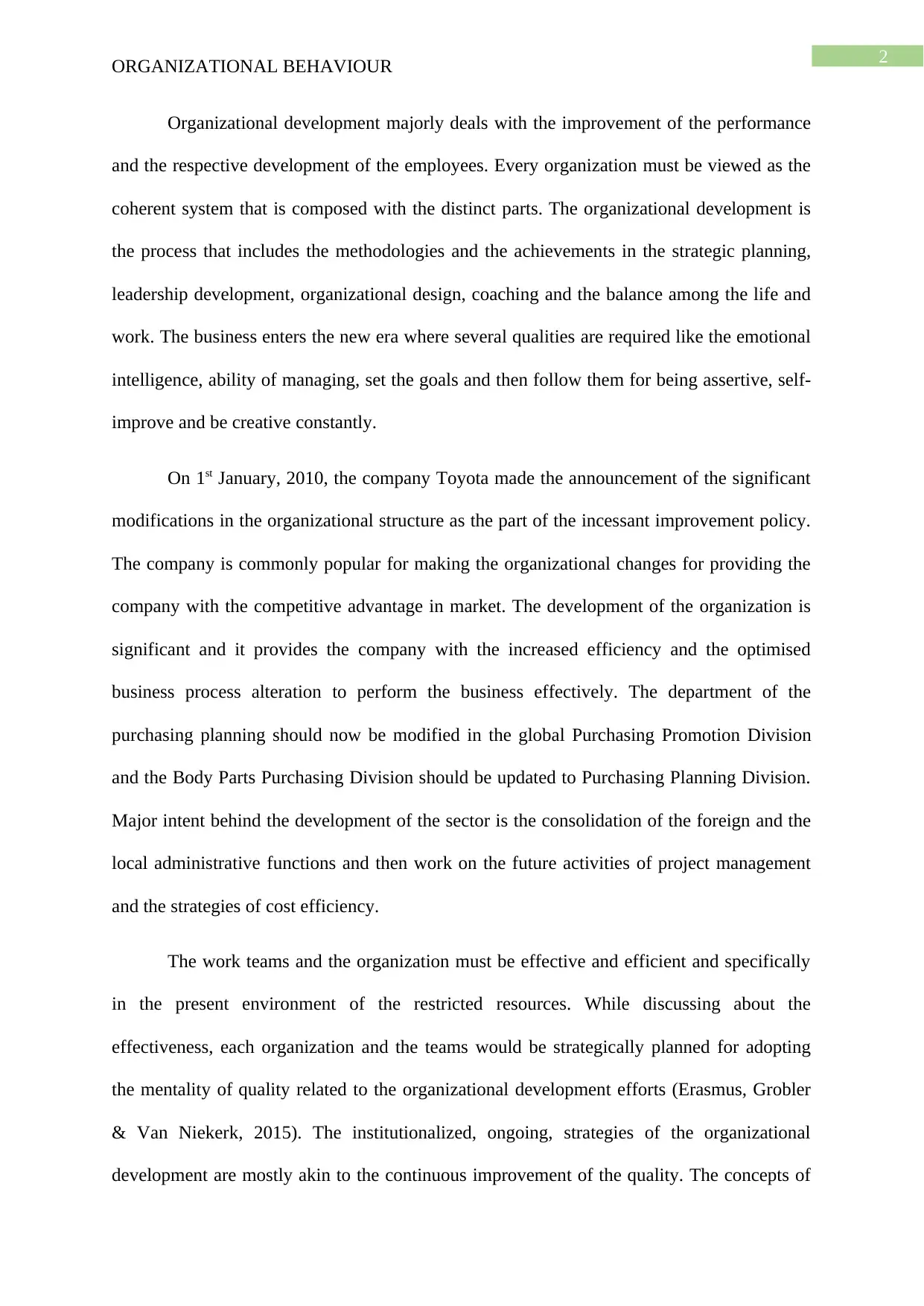
2
ORGANIZATIONAL BEHAVIOUR
Organizational development majorly deals with the improvement of the performance
and the respective development of the employees. Every organization must be viewed as the
coherent system that is composed with the distinct parts. The organizational development is
the process that includes the methodologies and the achievements in the strategic planning,
leadership development, organizational design, coaching and the balance among the life and
work. The business enters the new era where several qualities are required like the emotional
intelligence, ability of managing, set the goals and then follow them for being assertive, self-
improve and be creative constantly.
On 1st January, 2010, the company Toyota made the announcement of the significant
modifications in the organizational structure as the part of the incessant improvement policy.
The company is commonly popular for making the organizational changes for providing the
company with the competitive advantage in market. The development of the organization is
significant and it provides the company with the increased efficiency and the optimised
business process alteration to perform the business effectively. The department of the
purchasing planning should now be modified in the global Purchasing Promotion Division
and the Body Parts Purchasing Division should be updated to Purchasing Planning Division.
Major intent behind the development of the sector is the consolidation of the foreign and the
local administrative functions and then work on the future activities of project management
and the strategies of cost efficiency.
The work teams and the organization must be effective and efficient and specifically
in the present environment of the restricted resources. While discussing about the
effectiveness, each organization and the teams would be strategically planned for adopting
the mentality of quality related to the organizational development efforts (Erasmus, Grobler
& Van Niekerk, 2015). The institutionalized, ongoing, strategies of the organizational
development are mostly akin to the continuous improvement of the quality. The concepts of
ORGANIZATIONAL BEHAVIOUR
Organizational development majorly deals with the improvement of the performance
and the respective development of the employees. Every organization must be viewed as the
coherent system that is composed with the distinct parts. The organizational development is
the process that includes the methodologies and the achievements in the strategic planning,
leadership development, organizational design, coaching and the balance among the life and
work. The business enters the new era where several qualities are required like the emotional
intelligence, ability of managing, set the goals and then follow them for being assertive, self-
improve and be creative constantly.
On 1st January, 2010, the company Toyota made the announcement of the significant
modifications in the organizational structure as the part of the incessant improvement policy.
The company is commonly popular for making the organizational changes for providing the
company with the competitive advantage in market. The development of the organization is
significant and it provides the company with the increased efficiency and the optimised
business process alteration to perform the business effectively. The department of the
purchasing planning should now be modified in the global Purchasing Promotion Division
and the Body Parts Purchasing Division should be updated to Purchasing Planning Division.
Major intent behind the development of the sector is the consolidation of the foreign and the
local administrative functions and then work on the future activities of project management
and the strategies of cost efficiency.
The work teams and the organization must be effective and efficient and specifically
in the present environment of the restricted resources. While discussing about the
effectiveness, each organization and the teams would be strategically planned for adopting
the mentality of quality related to the organizational development efforts (Erasmus, Grobler
& Van Niekerk, 2015). The institutionalized, ongoing, strategies of the organizational
development are mostly akin to the continuous improvement of the quality. The concepts of
⊘ This is a preview!⊘
Do you want full access?
Subscribe today to unlock all pages.

Trusted by 1+ million students worldwide
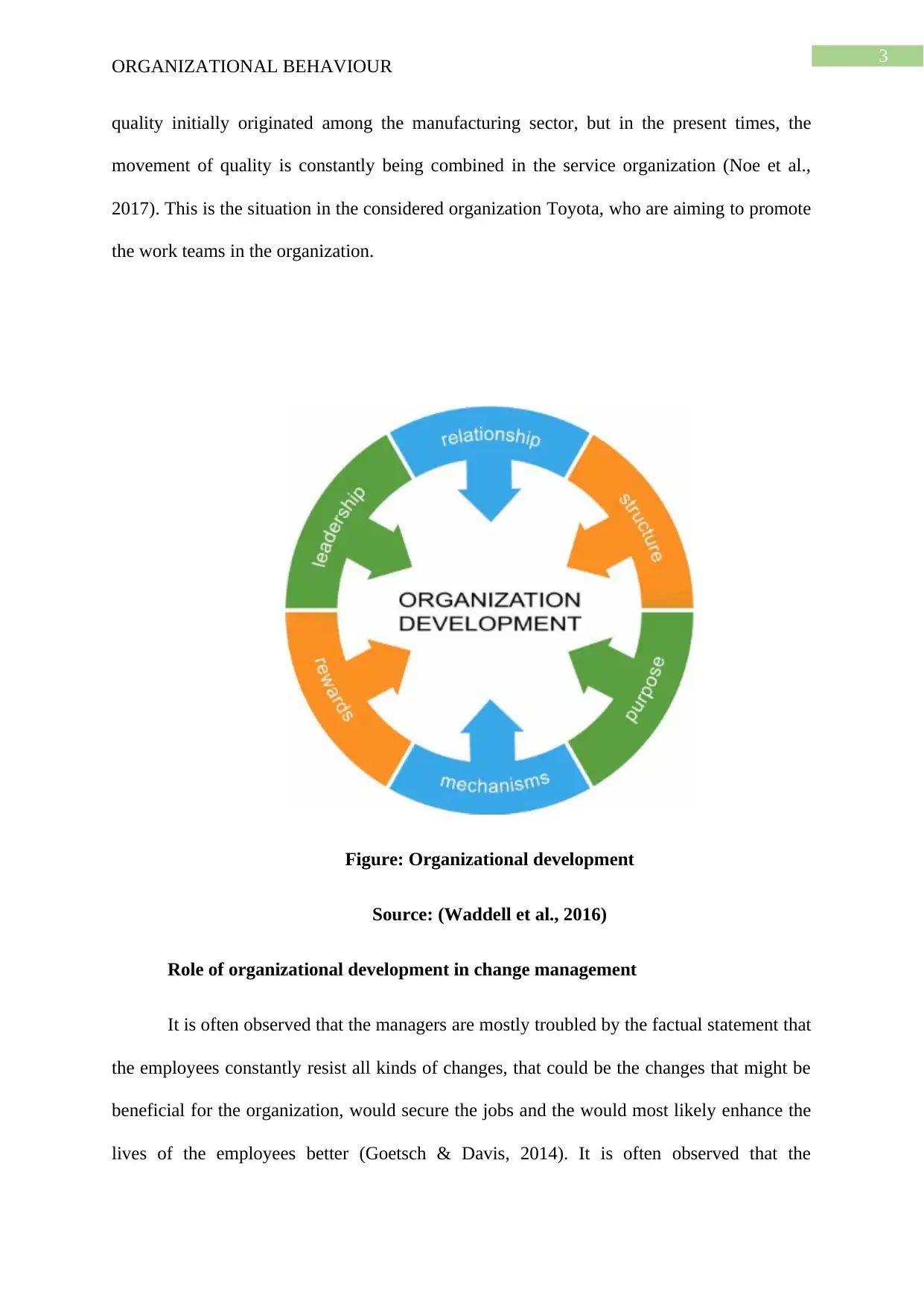
3
ORGANIZATIONAL BEHAVIOUR
quality initially originated among the manufacturing sector, but in the present times, the
movement of quality is constantly being combined in the service organization (Noe et al.,
2017). This is the situation in the considered organization Toyota, who are aiming to promote
the work teams in the organization.
Figure: Organizational development
Source: (Waddell et al., 2016)
Role of organizational development in change management
It is often observed that the managers are mostly troubled by the factual statement that
the employees constantly resist all kinds of changes, that could be the changes that might be
beneficial for the organization, would secure the jobs and the would most likely enhance the
lives of the employees better (Goetsch & Davis, 2014). It is often observed that the
ORGANIZATIONAL BEHAVIOUR
quality initially originated among the manufacturing sector, but in the present times, the
movement of quality is constantly being combined in the service organization (Noe et al.,
2017). This is the situation in the considered organization Toyota, who are aiming to promote
the work teams in the organization.
Figure: Organizational development
Source: (Waddell et al., 2016)
Role of organizational development in change management
It is often observed that the managers are mostly troubled by the factual statement that
the employees constantly resist all kinds of changes, that could be the changes that might be
beneficial for the organization, would secure the jobs and the would most likely enhance the
lives of the employees better (Goetsch & Davis, 2014). It is often observed that the
Paraphrase This Document
Need a fresh take? Get an instant paraphrase of this document with our AI Paraphraser
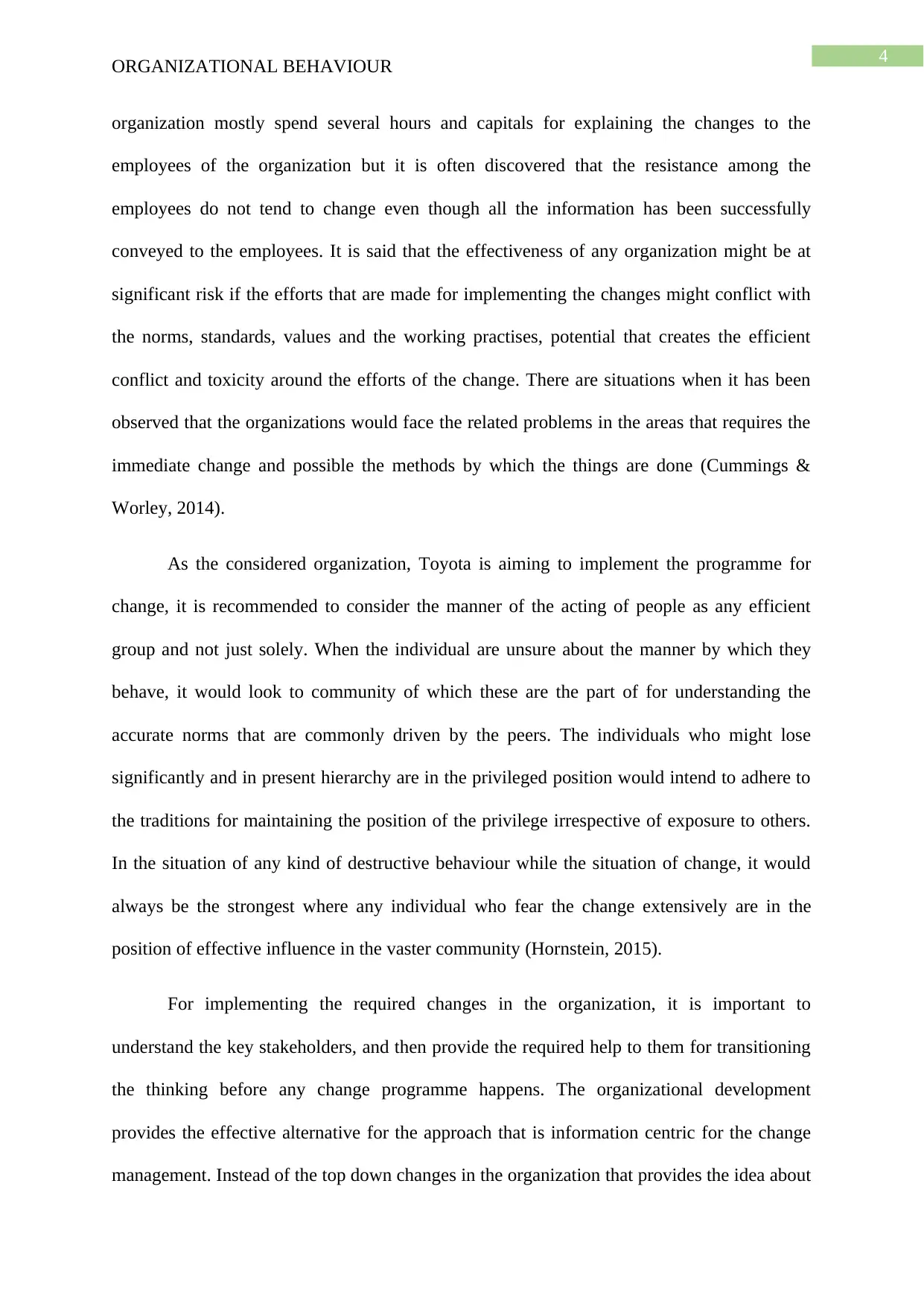
4
ORGANIZATIONAL BEHAVIOUR
organization mostly spend several hours and capitals for explaining the changes to the
employees of the organization but it is often discovered that the resistance among the
employees do not tend to change even though all the information has been successfully
conveyed to the employees. It is said that the effectiveness of any organization might be at
significant risk if the efforts that are made for implementing the changes might conflict with
the norms, standards, values and the working practises, potential that creates the efficient
conflict and toxicity around the efforts of the change. There are situations when it has been
observed that the organizations would face the related problems in the areas that requires the
immediate change and possible the methods by which the things are done (Cummings &
Worley, 2014).
As the considered organization, Toyota is aiming to implement the programme for
change, it is recommended to consider the manner of the acting of people as any efficient
group and not just solely. When the individual are unsure about the manner by which they
behave, it would look to community of which these are the part of for understanding the
accurate norms that are commonly driven by the peers. The individuals who might lose
significantly and in present hierarchy are in the privileged position would intend to adhere to
the traditions for maintaining the position of the privilege irrespective of exposure to others.
In the situation of any kind of destructive behaviour while the situation of change, it would
always be the strongest where any individual who fear the change extensively are in the
position of effective influence in the vaster community (Hornstein, 2015).
For implementing the required changes in the organization, it is important to
understand the key stakeholders, and then provide the required help to them for transitioning
the thinking before any change programme happens. The organizational development
provides the effective alternative for the approach that is information centric for the change
management. Instead of the top down changes in the organization that provides the idea about
ORGANIZATIONAL BEHAVIOUR
organization mostly spend several hours and capitals for explaining the changes to the
employees of the organization but it is often discovered that the resistance among the
employees do not tend to change even though all the information has been successfully
conveyed to the employees. It is said that the effectiveness of any organization might be at
significant risk if the efforts that are made for implementing the changes might conflict with
the norms, standards, values and the working practises, potential that creates the efficient
conflict and toxicity around the efforts of the change. There are situations when it has been
observed that the organizations would face the related problems in the areas that requires the
immediate change and possible the methods by which the things are done (Cummings &
Worley, 2014).
As the considered organization, Toyota is aiming to implement the programme for
change, it is recommended to consider the manner of the acting of people as any efficient
group and not just solely. When the individual are unsure about the manner by which they
behave, it would look to community of which these are the part of for understanding the
accurate norms that are commonly driven by the peers. The individuals who might lose
significantly and in present hierarchy are in the privileged position would intend to adhere to
the traditions for maintaining the position of the privilege irrespective of exposure to others.
In the situation of any kind of destructive behaviour while the situation of change, it would
always be the strongest where any individual who fear the change extensively are in the
position of effective influence in the vaster community (Hornstein, 2015).
For implementing the required changes in the organization, it is important to
understand the key stakeholders, and then provide the required help to them for transitioning
the thinking before any change programme happens. The organizational development
provides the effective alternative for the approach that is information centric for the change
management. Instead of the top down changes in the organization that provides the idea about
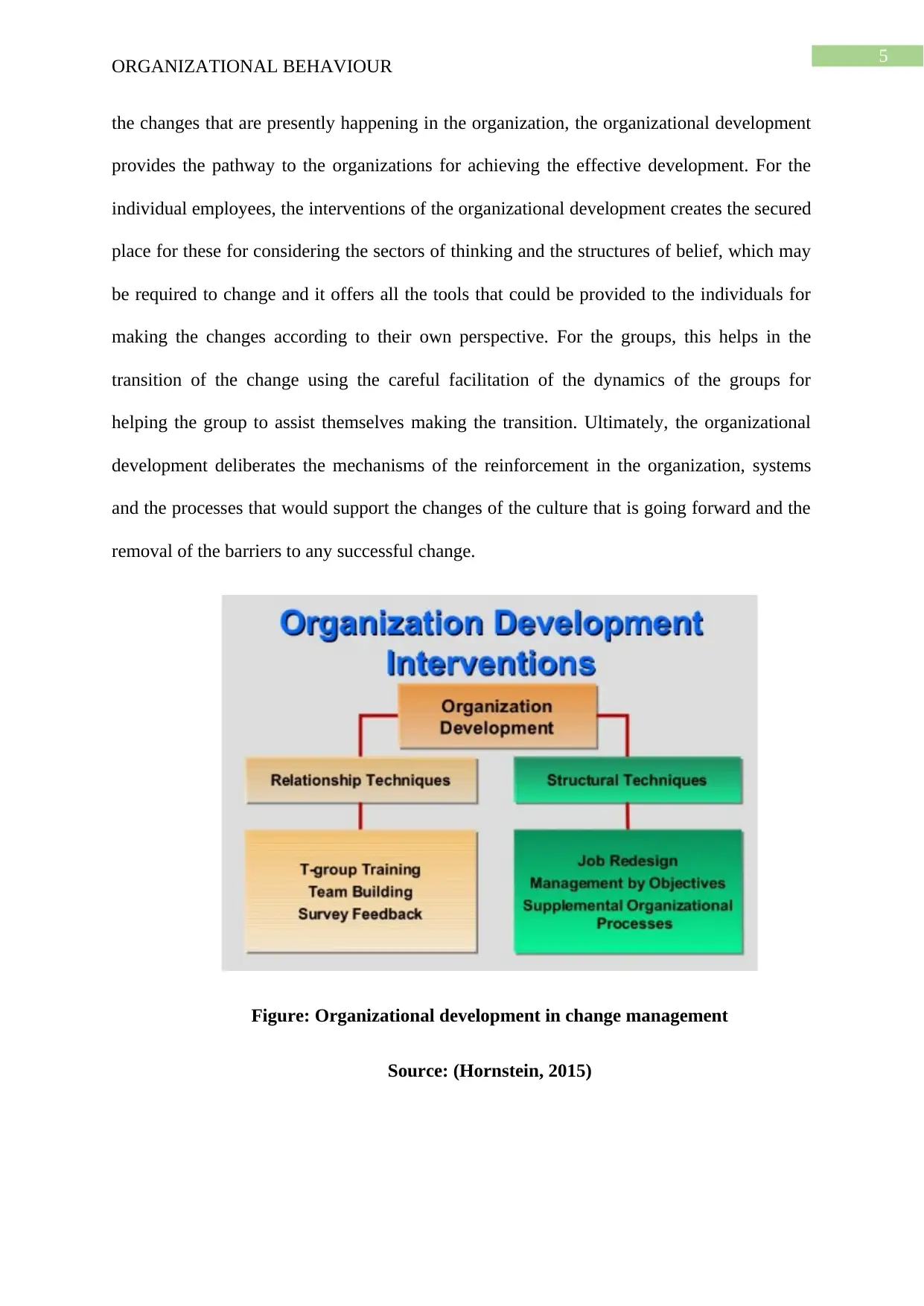
5
ORGANIZATIONAL BEHAVIOUR
the changes that are presently happening in the organization, the organizational development
provides the pathway to the organizations for achieving the effective development. For the
individual employees, the interventions of the organizational development creates the secured
place for these for considering the sectors of thinking and the structures of belief, which may
be required to change and it offers all the tools that could be provided to the individuals for
making the changes according to their own perspective. For the groups, this helps in the
transition of the change using the careful facilitation of the dynamics of the groups for
helping the group to assist themselves making the transition. Ultimately, the organizational
development deliberates the mechanisms of the reinforcement in the organization, systems
and the processes that would support the changes of the culture that is going forward and the
removal of the barriers to any successful change.
Figure: Organizational development in change management
Source: (Hornstein, 2015)
ORGANIZATIONAL BEHAVIOUR
the changes that are presently happening in the organization, the organizational development
provides the pathway to the organizations for achieving the effective development. For the
individual employees, the interventions of the organizational development creates the secured
place for these for considering the sectors of thinking and the structures of belief, which may
be required to change and it offers all the tools that could be provided to the individuals for
making the changes according to their own perspective. For the groups, this helps in the
transition of the change using the careful facilitation of the dynamics of the groups for
helping the group to assist themselves making the transition. Ultimately, the organizational
development deliberates the mechanisms of the reinforcement in the organization, systems
and the processes that would support the changes of the culture that is going forward and the
removal of the barriers to any successful change.
Figure: Organizational development in change management
Source: (Hornstein, 2015)
⊘ This is a preview!⊘
Do you want full access?
Subscribe today to unlock all pages.

Trusted by 1+ million students worldwide
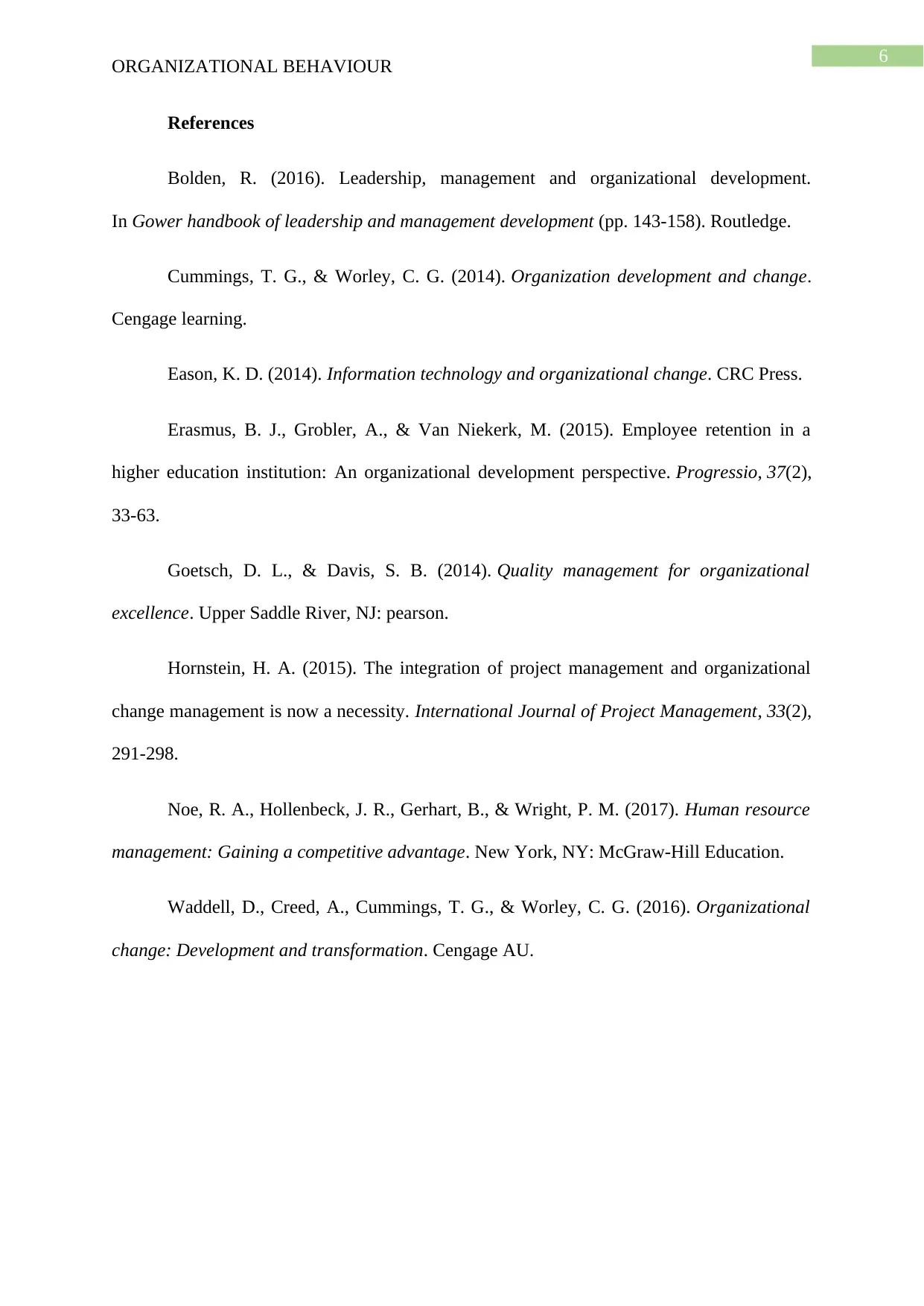
6
ORGANIZATIONAL BEHAVIOUR
References
Bolden, R. (2016). Leadership, management and organizational development.
In Gower handbook of leadership and management development (pp. 143-158). Routledge.
Cummings, T. G., & Worley, C. G. (2014). Organization development and change.
Cengage learning.
Eason, K. D. (2014). Information technology and organizational change. CRC Press.
Erasmus, B. J., Grobler, A., & Van Niekerk, M. (2015). Employee retention in a
higher education institution: An organizational development perspective. Progressio, 37(2),
33-63.
Goetsch, D. L., & Davis, S. B. (2014). Quality management for organizational
excellence. Upper Saddle River, NJ: pearson.
Hornstein, H. A. (2015). The integration of project management and organizational
change management is now a necessity. International Journal of Project Management, 33(2),
291-298.
Noe, R. A., Hollenbeck, J. R., Gerhart, B., & Wright, P. M. (2017). Human resource
management: Gaining a competitive advantage. New York, NY: McGraw-Hill Education.
Waddell, D., Creed, A., Cummings, T. G., & Worley, C. G. (2016). Organizational
change: Development and transformation. Cengage AU.
ORGANIZATIONAL BEHAVIOUR
References
Bolden, R. (2016). Leadership, management and organizational development.
In Gower handbook of leadership and management development (pp. 143-158). Routledge.
Cummings, T. G., & Worley, C. G. (2014). Organization development and change.
Cengage learning.
Eason, K. D. (2014). Information technology and organizational change. CRC Press.
Erasmus, B. J., Grobler, A., & Van Niekerk, M. (2015). Employee retention in a
higher education institution: An organizational development perspective. Progressio, 37(2),
33-63.
Goetsch, D. L., & Davis, S. B. (2014). Quality management for organizational
excellence. Upper Saddle River, NJ: pearson.
Hornstein, H. A. (2015). The integration of project management and organizational
change management is now a necessity. International Journal of Project Management, 33(2),
291-298.
Noe, R. A., Hollenbeck, J. R., Gerhart, B., & Wright, P. M. (2017). Human resource
management: Gaining a competitive advantage. New York, NY: McGraw-Hill Education.
Waddell, D., Creed, A., Cummings, T. G., & Worley, C. G. (2016). Organizational
change: Development and transformation. Cengage AU.
Paraphrase This Document
Need a fresh take? Get an instant paraphrase of this document with our AI Paraphraser

7
ORGANIZATIONAL BEHAVIOUR
ORGANIZATIONAL BEHAVIOUR

8
ORGANIZATIONAL BEHAVIOUR
ORGANIZATIONAL BEHAVIOUR
⊘ This is a preview!⊘
Do you want full access?
Subscribe today to unlock all pages.

Trusted by 1+ million students worldwide

9
ORGANIZATIONAL BEHAVIOUR
ORGANIZATIONAL BEHAVIOUR
1 out of 10
Related Documents
Your All-in-One AI-Powered Toolkit for Academic Success.
+13062052269
info@desklib.com
Available 24*7 on WhatsApp / Email
![[object Object]](/_next/static/media/star-bottom.7253800d.svg)
Unlock your academic potential
Copyright © 2020–2025 A2Z Services. All Rights Reserved. Developed and managed by ZUCOL.



